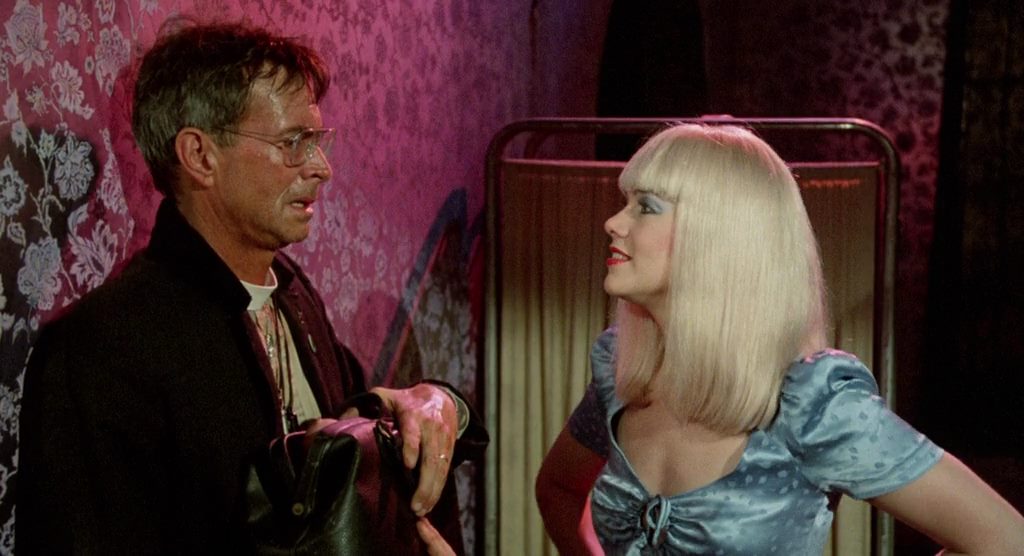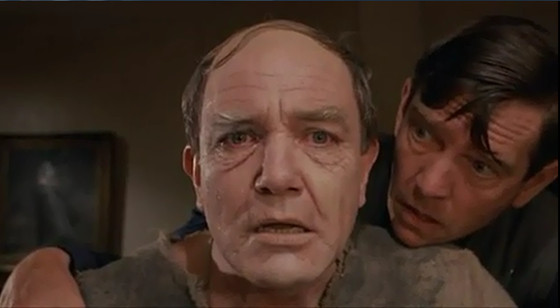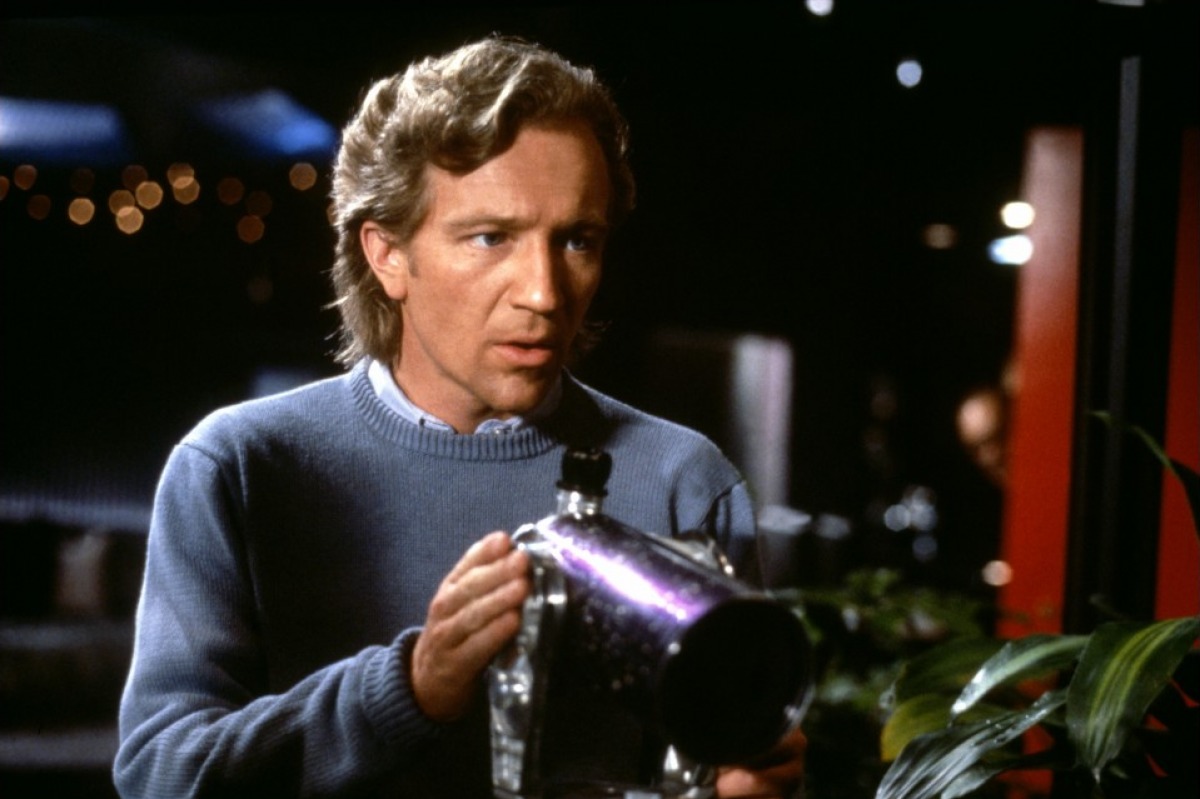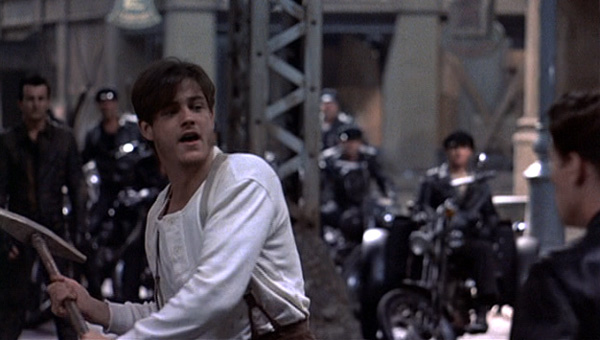6. The Dresser (1983)
Films based on plays are always a queer lot. Necessarily hybrid by nature, they lead a doppelgänger life and rarely cohere. There is a pretty wide gap between writing for the stage and writing for the screen and what sounds like genius in one format makes for a tedious evening in another. Directors feel compelled to “open” up the play to overcompensate for the rigidity of the theatrical form. It’s a delicate balance not often achieved.
The Dresser, I am happy to say, is one of the few that solves the riddle and breaks the mold, due mainly because a vast majority of the film takes place back- and on-stage in a theatrical setting, with actors performing their parts, so there is little need to compromise the words or setting.
Starring Albert Finney as “Sir,” and Tom Courtenay as “Norman,” its mainly about how Norman, a dresser for an repertory theater troupe during WWII gets his man and lead actor — a cantankerous old sot — to remember his lines and perform every night. The troupe mainly specializes in Shakespeare, with King Lear being particularly relevant. The script was written by Ronald Harwood, based on his personal stage experiences as a real-life dresser.
The entire production is lovingly crafted with great attention to detail and much opportunity to hear bits from very famous plays splendidly acted. The two lead actors were both nominated for Best Actor Oscars® with both loosing out to Robert Duvall in Tender Mercies (1983).
To say anything else would ruin this fine film. As fate would have it, a remake is planned for release later this year with Anthony Hopkins as “Sir” and Ian McKellen as “Norman.” While I can’t speak for the remake as of yet, hopefully this will bring the original film back into circulation. Rare — if ever — is a remake better than the first.
7. Crimes of Passion (1984)

Ken Russell is perhaps one of the most underappreciated film directors ever.
Always the gadfly, always pushing buttons like an evil sorcerer — or titanic creative genius — behind the black curtain, his films have always provoked a response that’s usually, mistakenly, negative. He’s largely misunderstood and almost forgotten except for two films — Tommy (1975) and Altered States (1980) — and crafted a prolific outlier career that explored numerous subjects in a multitude of styles from biopics to sorcery that always challenged common preconceptions. He was not a filmmaker for someone craving the ordinary. His heyday was from the late 60s through 1989 and for 20 years he was cinema’s bad boy.
Crimes of Passion, made 4 years after Altered States, was his attempt at exploring the meaning of love, sex, desire, and forbidden fantasy. Kathleen Turner was the “it” girl of the early 80s and perfectly embodied the doppelgänger aspects of her character — prim and proper during the day but a ravenous whore during the night.
There is a lot more going on than meets the eye, however — it’s not all Strum und Drang, sex and rock & roll. Russell mixes in several scenes of intimacy, or the lack of it, as a truthful way of exploring sexual mores that constantly compete with societal and personal identities. It asks serious questions.
The music of Crimes of Passion is especially unique and classical. Rick Wakeman’s electronica version of Antonin Dvorák’s Symphony #9 in E minor “From the New World” (mainly the second movement) is the only piece of music one hears and in endless variation. In fact, music is a definite directorial signature of Russell’s and often a “character” in its own right in ways not too dissimilar from Kubrick.
The film was poorly received. Massively recut to achieve an “R” rating, it lost its bite. Emasculated, what was left seemed more sordid than exploratory. Backstory was compromised. Emotion lost. Crimes of Passion is not a perfect film. There are serious flaws that make it difficult to watch, not the least is Anthony Perkins’ over-the-top performance which doesn’t always gel as it quite should and John Laughlin’s wooden performance. Flaws aside, even as a mid-career failure for Russell, it’s worth your time.
8. Body Double (1984)
Body Double not only lives in the same universe as Crimes of Passion, they are two peas from the same pod. But both director’s concept and approach couldn’t be more different and the visual style farther apart. In a sense, Brian De Palma is America’s version of Ken Russell’s British enfante terrible but as an interesting combination of Hitchcock and Dario Argento. De Palma is not afraid to let the blood gush and the sex steam, often in the same frame.
In the same way America did not respond to Crimes of Passion, it didn’t really take to Body Double either. Both pictures exhibit serious flaws but both pictures have the strength of their convictions to carry them through. Crimes of Passion’s sordidness — a Priest with sexual and murderous fantasies — crossed a line with the public.
Americans don’t want to be reminded that religious folks are real people too. And when our heroine in Body Double quite literally gets “drilled” in a horrifically violent sequence, you feel the film lost its innocence and it was no longer a murder mystery masquerading as entertainment.
Body Double’s cross-pollination between satire and tragedy, violence and voyeurism freaked people out. Its genius middle-of-the-picture MTV moment has the star (Craig Wasson) wandering (voyeuring) through an S&M bar set to the tune of “Relax” and performed by Frankie Goes to Hollywood. It’s an extraordinary sequence that comes out of nowhere, oddly fitted, thrilling, and plays on the whole film-within-a-film reality vs. fiction themes.
The audience had a hard time adjusting their moods — the films pendulum swung broadly and frequently and it’s-just-a-movie story arc did not pare well with the violent murder or the let’s-pin-the-whole-thing-on-a-patsy conclusion.
Still, the film is a work of art and one of De Palma’s craziest best. In 1984, Body Double, he was riding a crest of remarkable series of films that included Sisters (1973), Carrie (1976), The Fury (1978), Dressed to Kill (1980), Blow Out (1981), and Scarface (1983), with The Untouchables (1987), and Mission Impossible (1996) still to come. Prolific, challenging, and varied, all of his films, with few exceptions, should be remembered, especially Body Double, which suffered an unwarranted fate worst of all.
9. Streets of Fire (1984)
There are directors, and then there is Walter Hill. Hot on the emerging craze of music videos, this always on-the-edge film director crafts a feature-length, music video fairy tale before anyone knew what had hit them. Hill’s influence on the style future music video directors would employ was huge.
This film had many detractors, chief among them one of the film’s stars — Rick Moranis — who hated every day he had to come to set and made sure everyone knew about it. Looking at the film now with hindsight, it’s easy to see how easily this film could be misunderstood and even disliked. Like The Stunt Man, it appeares to exists in several worlds, but here all strung together by musical numbers and a production design concept that can only be characterized as hugely eclectic.
The fakeness of the studio sets was intentional. It was meant to seem like a fairy tale, as though an animated Disney film came to life. All the characters represented broad archetypes and the dialog was intentionally theatrical and over-the-top. Even the open title card tried to prepare you for what was to come: “Another Time… Another Place.” Perhaps the greatest disappointment was its lead, Michael Paré. If you don’t buy into his performance choices and deadpan delivery, the movie falls apart.
Flaws aside, this is a marvelously conceived picture, handsome to look at, great to listen to, and expertly, even lovingly, crafted. I was not exaggerating when I say Walter Hill almost invented the MTV art form and style. He is a master craftsman and knew how to construct a picture either as director or producer or writer.
As producer, he was behind the scenes for the Alien tentpole from the start. As a director, he specialized in hard-driving buddy pictures: The Driver (1978), The Warriors (1979), The Long Riders (1980), and Southern Comfort (1981). He would produce 48 Hrs. (1982) and he wrote almost all of them.
So, when Streets of Fire came along, I am sure many had a WTF moment. Intended as a trilogy, it never got beyond first base. Today, the film would be better received. See it. Live it. Experience it.
10. Birdy (1984)
Alan Parker tries very hard and his best efforts — Bugsy Malone (1975), Midnight Express (1978), Fame (1980), Pink Floyd The Wall (1982), Birdy (1984), and Angel Heart (1987) — his last truly great film — create a world of complete immersion. Evita (1996) was a magnificent, glorious misfire. Angel’s Ashes (1999) was a difficult biography about dark times. After that, he would only make 8 more films in the next 20 years.
You feel his films like few others. Their reality is palpable and their emotion true. He worked in a variety of genres and employed a variety of styles, always inventive and very creative. Like Ridley Scott, who shares a similar career arc, Parker’s years as an Ad man directing TV spots shaped his imagination and interest — musicals, thrillers, dramas, literary adaptations— he did it all.
Birdy was a great, critical success and Parker was heaped with praise for trying to tackle an almost unfilmable book and somehow make it into a great film. The story follows two close friends — “Birdy,” played by Matthew Modine, one of his first screen roles, and “Al,” played by Nicholas Cage, an up-and-coming star — who come back from the horrors of the Viet Nam war and attempt to recover from debilitating psychological and physical injuries.
At times, it’s a deeply dark, even depressing film while Al tries to coax his friend out of his unresponsive, somnambulant state before the doctors give up on him and send him off to a mental institution. Al rehashes their childhood, their war experience, and their deepest feelings. This is probably part of the reason it has disappeared — it’s not an easy sit and something you’re not likely watch over and over.
Birdy, and Angel Heart (1987) two years later, represent the high point of Parker’s fine career.



